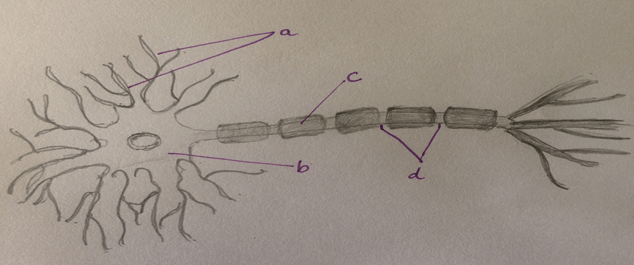This set of Cell Biology Multiple Choice Questions & Answers (MCQs) focuses on “Cellular Membranes – Membrane Potential and Nerve Impulses”.
1. Response to external stimulus is called _______________
a) reaction
b) immunity
c) response
d) irritability
View Answer
Explanation: All organisms respond to external stimulus, a property known as irritability. Even the smallest amoeba and bacterial cell possess this feature. In response to external stimulus, a cell may activate from its whole range of metabolic pathways.
2. Information is coded in the form of fast moving impulse in which types of cells?
a) epithelial
b) endothelial
c) neurons
d) hepatocytes
View Answer
Explanation: Nerve cells are called neurons; they conduct, transmit and collect information in form of electrical impulses. The structure of neurons is unique and different from other cells in the body.
3. Which part of a neuron receives information from other neurons?
a) cell body
b) axon
c) dendrites
d) myelin sheath
View Answer
Explanation: The fine extensions from cell body of the neurons are called dendrites which receive information from external sources, usually other neighboring neurons.
4. The information is forwarded from the neuron through which part?
a) axon
b) soma
c) dendrites
d) nucleus
View Answer
Explanation: Axon is a single prominent extension that emerges from the cell body and is responsible for conducting outgoing impulses away from the cell and towards other cells.
5. Myelin sheath is composed mainly of _____________
a) proteins
b) lipids
c) nucleic acids
d) cholesterol
View Answer
Explanation: Myelin sheath surrounds the axon which extends from the soma of a neuron. Myelin sheath is composed mainly of lipids and their function is to prevent loss of impulses.
6. Membrane potential is present only in nerve cells.
a) True
b) False
View Answer
Explanation: A membrane potential of -70 mV is present in neurons. However this phenomena is not specific to neurons, membrane potential exists in other types of cells as well from anywhere between -15 to -100 mV.
7. Which of the following exists in nerve and muscle cells?
a) resting potential
b) membrane potential
c) potassium equilibrium potential
d) sodium equilibrium potential
View Answer
Explanation: Nerve and muscle cells are the only excitable cells in the body; the potential difference that exists between extracellular and intracellular environments is termed as resting potential. However in other cells this voltage is termed as membrane potential.
8. Which of the following has the highest permeability in a resting nerve cell?
a) Na+
b) Cl–
c) I–
d) K+
View Answer
Explanation: K+ has the highest permeability in resting nerve cells. Most of the ion channels open in the membrane of a resting nerve cell are selective for potassium, referred to as potassium leak channels.
9. On which of the following organisms, the research on nerve cells was first carried out?
a) Drosophila melanogaster
b) Grasshopper
c) Giant squid
d) Octopus
View Answer
Explanation: The first research on action potential and nerve impulses was carried on the axons of giant squid in the late 1940s and early 1950s by Alan Hodgkin, Andrew Huxley, and Bernard Katz.
10. Depolarization is when ___________ ions flow inside the neuron’s membrane.
a) Potassium
b) Sodium
c) Chloride
d) Magnesium
View Answer
Explanation: Depolarization is the flow of sodium ions into the membrane. These are positively charged and reduce the polarity of a cell with respect to external environment and are therefore cause depolarization.
11. A neuron fires when _____________________
a) action potential is achieved
b) apoptosis is induced
c) re-stimulation occurs
d) stimulation ceases
View Answer
Explanation: When the external stimulation is strong enough to reach the threshold value which is around -50 mV, the action potential is generated, and firing of the neurons occurs. This is actually the response to stimulus.
12. Saltatory conduction occurs due to _______________
a) axon hillock
b) soma
c) myelin sheath
d) nodes of ranvier
View Answer
Explanation: Saltatory conduction occurs due to nodes of Ranvier on the length of the axon. Due to this, the action potential jumps from one node to the other, resulting in faster action potential transmission.
13. The parts in the figure are a)__________, b)_____________, c)___________, d)____________.

a) dendrites, soma, myelin sheath, nodes of ranvier
b) dendrites, soma, cell body, axon hillock, myelin sheath
c) soma, axon hillock, myelin sheath, dendrites
d) soma, axon hillock, axon, dendrites
View Answer
Explanation: Dendrites are the fine extensions from cell body, responsible for receiving information from other neurons. The information is processed in soma and then travels down the length of the axon where myelin sheath is discontinuously present. The gaps between the sheath are called nodes of Ranvier.
14. Local anesthetics act by _____________ the ion channels.
a) inactivating
b) opening
c) closing
d) mutating
View Answer
Explanation: Local anesthetics act by closing the ions channels present in the membranes of sensory cells and neurons. As a result no action potential is generated and information can not be sent to the brain about events occurring at the skin or teeth.
15. Action potential can only flow in the forward direction.
a) True
b) False
View Answer
Explanation: Action potential can only move in the forward direction generating nerve impulses. This is because the area of the membrane that has just experienced action potential, remains in a refractory period and can not be stimulated again.
Sanfoundry Global Education & Learning Series – Cell Biology.
To practice all areas of Cell Biology, here is complete set of 1000+ Multiple Choice Questions and Answers.
If you find a mistake in question / option / answer, kindly take a screenshot and email to [email protected]
- Check Biotechnology Books
- Practice Biotechnology MCQs
- Apply for Biotechnology Internship
- Check Cell Biology Books
